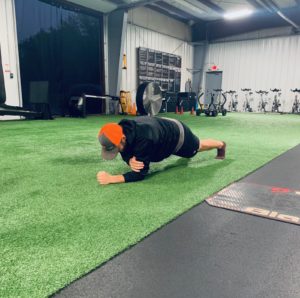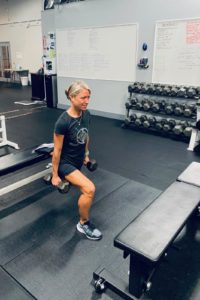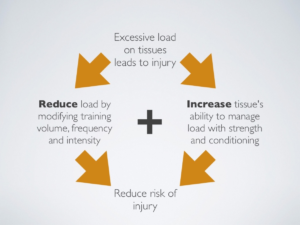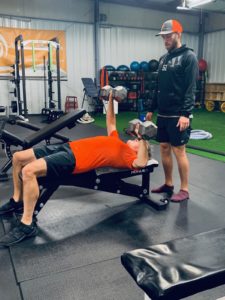By: Erin Young
“I’m a runner, why should I strength train?” I get this question often and honestly there is no single, easy answer. But I do believe there is a time for strength training in every athlete’s year. It will look different for every runner. It may be an off season activity while the snow flies, it could be three days a week up until the competition or just 20 minutes a day to work on core, balance or weaknesses.
year. It will look different for every runner. It may be an off season activity while the snow flies, it could be three days a week up until the competition or just 20 minutes a day to work on core, balance or weaknesses.
In the last decade, new research is showing that strength training can benefit many kinds of endurance runners–if the right types of it are done in the right doses. This newer research suggests that strength training can enhance endurance-running performance by improving running economy, delaying the onset of fatigue, improving maximal speed, and increasing anaerobic capacity.
When broken down to its components, strength training temporarily overloads the neuromuscular system, which allows for an improved ability to recruit individual muscular units, an increase in muscle-firing frequency, increased muscle-tendon stiffness (allowing you to have more stored energy with each step), and improved muscular coordination over time. These are all minor physiological changes but together and over time equal running-economy improvement which allows you to run a given pace with a little less effort.
“But Won’t I Bulk Up?”: Addressing Strength-Training Fears
The most common concern I hear from endurance runners is the fear of putting on bulk from strength training. Now there is something to be said for individual genetic predispositions, but science shows almost a complete lack of muscle growth with strength and endurance training–in correct dosing. Why is this? Muscle growth with concurrent strength and endurance training seems to be blocked on a molecular level.
As we’ve alluded to a couple times in this article so far, there appears to be a dosing ratio at play. When athletes maintain a 3:1 ratio in the number of endurance sessions to the number of strength sessions they perform, muscle growth doesn’t occur. So if an athlete wanted to gain mass while still getting some of the benefits of concurrent strength and endurance training, they would need to increase the number of strength sessions or decrease the number of endurance sessions.
 Strength Training and Injury Prevention
Strength Training and Injury Prevention
A lot of athletes will tell you that strength training helps them feel more durable. There is research suggesting that traditional strength training can reduce sports injuries significantly. This is done by increasing your tissue’s ability to manage load while modifying endurance-training volume and frequency.
For example, one study that replaced 30% of an athlete’s weekly running volume with strength training found that athletes remained injury free while improving their five-kilometer performances. Additionally, hard strength training has positive effects on circulating levels of testosterone and human growth hormone which can help the body repair muscular damage at faster rates post-hard-endurance and post-hard-strength-training efforts.
Maybe that’s what durability feels like? That is, creating enough physical change to more than manage your niggles and instead create more significant physiological adaptations that keep fatigue at bay longer and hold your form together longer because you increased your running economy. That is, you became physically stronger. I’m not certain we will ever have a perfect metric to measure durability, but if being stronger keeps you on the trail more consistently, that might be as close as we get to an answer.
Strength Training for the Aging Endurance Runner
When it comes to aging and declining endurance-running performance, naturally decreasing muscle mass seems to be the main culprit. This is because there is a direct link between the age-related decrease in VO2max and muscle-mass loss. This age-related muscle-mass loss starts somewhere just north of age 40 and accelerates rapidly after 70. Between the ages of 40 and 80 and with no intervention, you should expect to naturally lose approximately 40% of your muscle tissue. Also note that muscle loss in the aging woman appears to happen at a slightly increased rate than men.
What this means for our aging athletes is that strength training to maintain and build muscle mass is incredibly important. The current, best treatment for muscle loss is strength training. The general recommendation is that if you are over the age of 40 and not currently strength training, we should probably change that.
Need help with a strength training regimine for your next endurance event? Fall and winter is a great time to reduce your running load and hit the gym! Visit www.athleticmentors.com to see how we can make you better, faster and stronger on the trail!










